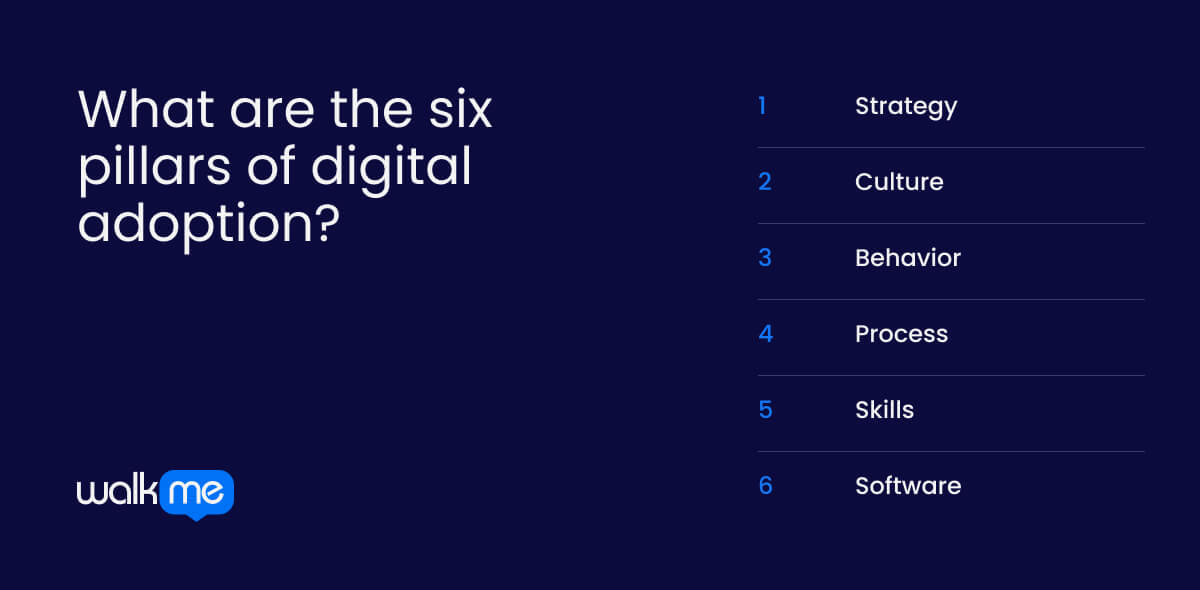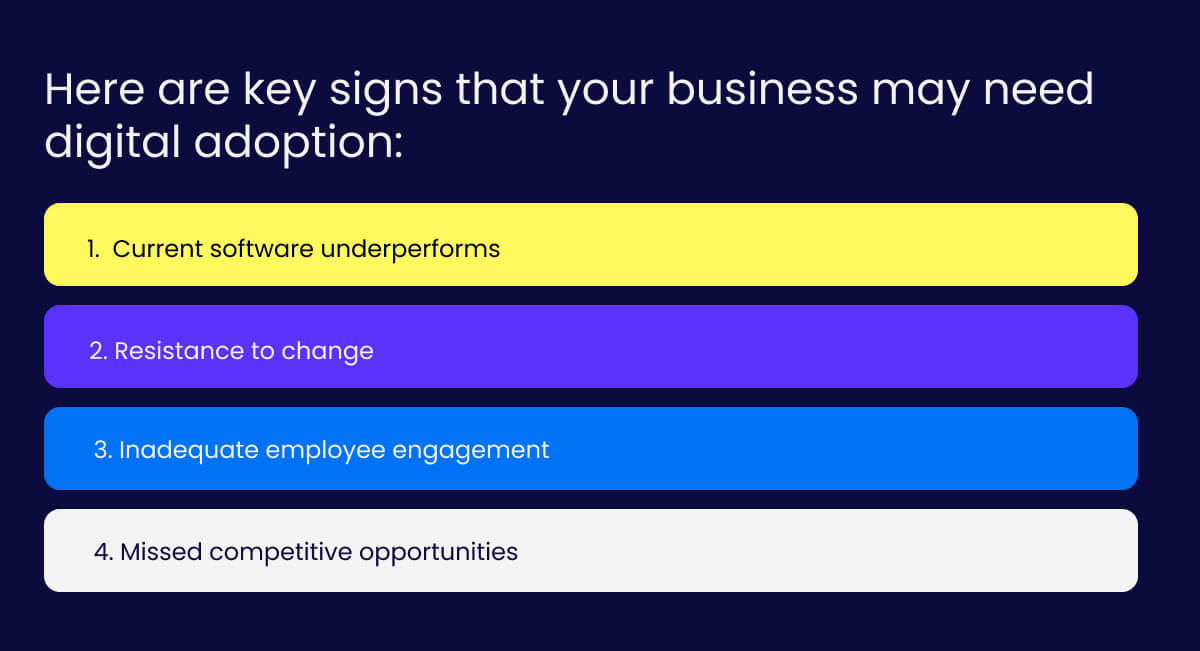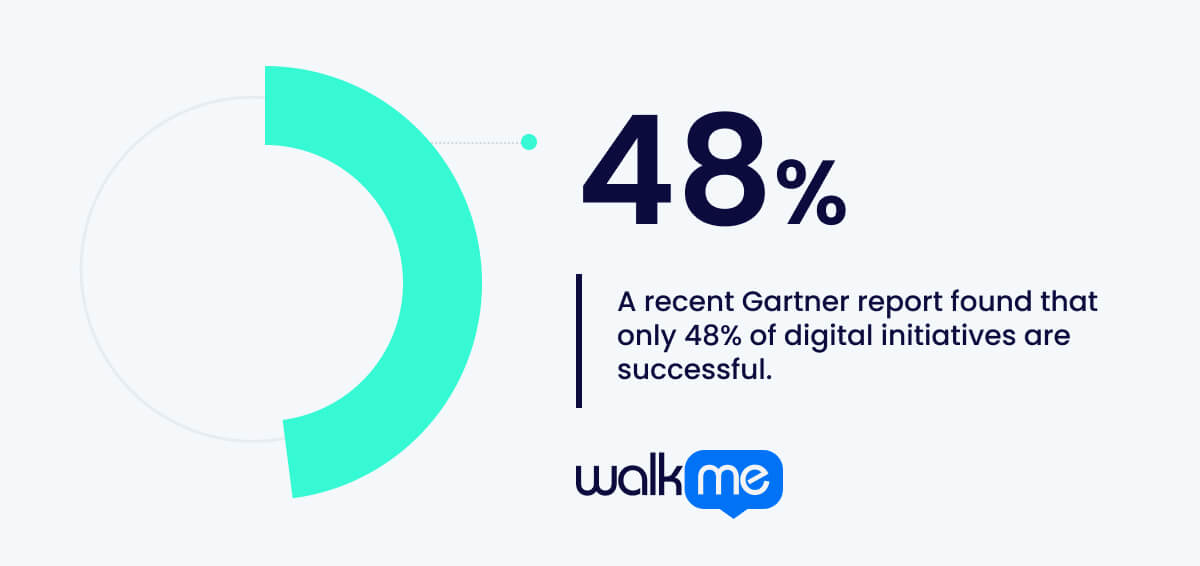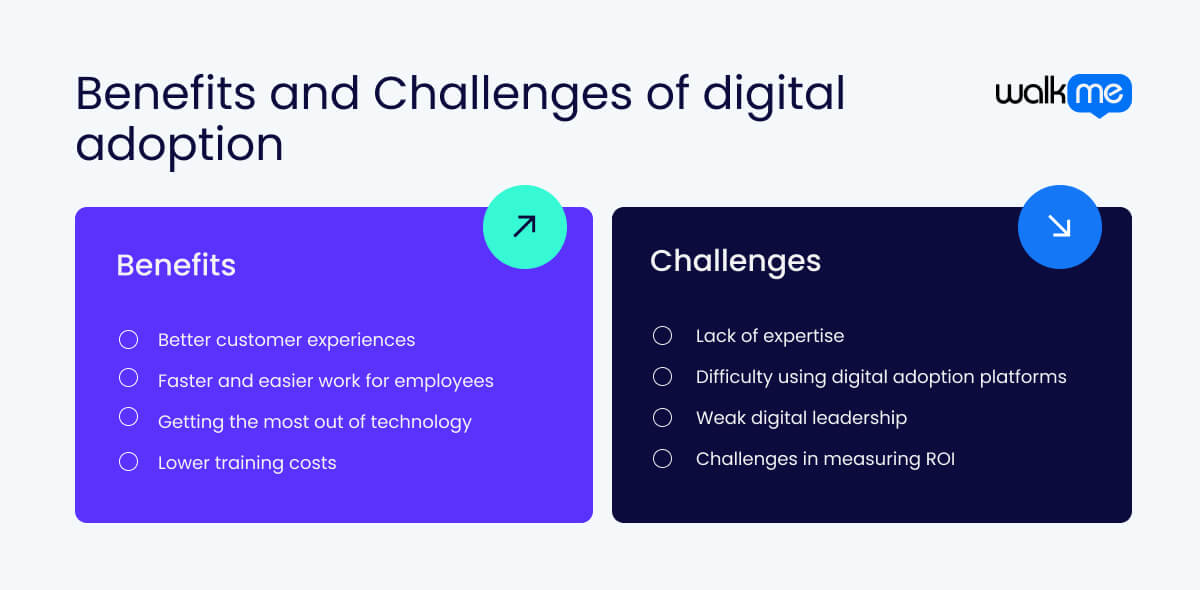What is digital adoption?
Software scalability refers to a system’s ability to handle an increasing workload efficiently. As more users interact with the software or data volume grows, a scalable system continues operating smoothly.

It also measures how well users understand and use a digital product’s features. True digital adoption happens when people know how to navigate the tool, use its features, and fit it into their daily tasks or processes. This ensures they can rely on the technology to meet their needs effectively.
WalkMe’s 2024 State of Digital Adoption report revealed that businesses lose an average of $1.14 million in productivity each week and waste 38% of their digital transformation budgets due to poor adoption of new tools and systems.
Why should businesses prioritize digital adoption?
Prioritizing digital adoption ensures that businesses fully utilize the tools they invest in.
Global IT spending is expected to reach $5.26 trillion in 2024, a 7.5% increase from 2023. With this growth, businesses must ensure their tools drive measurable outcomes, making digital adoption an essential strategy for success.

If tools aren’t fully adopted, they’re often underused, wasting time and money. When employees know how to use new systems, they can work faster and more efficiently, making everyday tasks smoother.
Without proper adoption, too many apps can confuse teams and lead to repeated tasks. This can make it hard to track progress and understand if tools are truly helping. Clear digital adoption strategies help companies avoid these pitfalls by streamlining tools and focusing on usability.
What is the scope of digital adoption?
A digital adoption solution (DAS) is a company-wide strategy, but its true scope goes beyond just implementing technology.
True digital adoption involves integrating digital tools into every aspect of your business. These tools must align with your goals and be embraced by employees and customers.
In recent years, businesses faced new challenges, such as the rapid shift to hybrid work. Companies prioritizing digital adoption adapted quickly by providing employees with the necessary tools and training to work remotely. Those who embraced digital tools and platforms survived the transition and made significant market gains.
Employees now expect a seamless experience when using digital tools, whether in the office or remotely. They want technology that integrates smoothly into their workflows without disruption.
Customers also demand intuitive digital experiences and are more likely to switch if your competitor offers a feature or convenience that you don’t. Businesses must stay ahead by continuously improving the usability and accessibility of their digital tools. This helps ensure they meet evolving customer and employee expectations.
McKinsey reports that in 2025, companies will adopt new software and invest heavily in technologies like AI, automation, and advanced analytics. Digital adoption strategies must integrate these technologies to maintain competitiveness and improve business efficiency.
This broader scope of digital adoption ensures companies are not just implementing isolated tools but are building a cohesive, future-proof digital ecosystem that drives growth, productivity, and customer retention.
What are the six pillars of digital adoption?

Digital adoption is a multifaceted process that requires attention to six key pillars. If any one pillar is neglected, the entire adoption process can falter.
Below are the crucial elements to consider when implementing digital adoption in your business:
Strategy
A well-defined strategy is essential for digital adoption. Without it, businesses risk wasting time and resources on ineffective tools. Ensure your digital strategy aligns with your business goals and is communicated to all employees. Everyone needs to understand how the new tools will impact their daily work and what the long-term benefits will be.
Culture
Culture plays a critical role in the success of digital adoption. Technology can only be effective if employees are willing to embrace it. Resistance or discomfort can create barriers to adoption and cultural transformation. Creating a culture where employees feel supported, valued, and confident with new technology is key to a smooth transition and long-term success.
Behavior
Digital adoption often introduces new organizational behaviors and processes, which can overwhelm employees. It’s important to offer continuous training and support to help them adjust. Regular check-ins, hands-on support, and clear guidance help employees become comfortable with the new tools and accelerate their learning process.
Process
Digital adoption should be part of a broader organizational transformation. Everyone, from leadership to individual teams, plays a role in ensuring successful implementation. Efficiency is vital during this phase, as delays or confusion can lead to wasted time and resources. Streamline processes to ensure everyone is on the same page and can contribute to the adoption effectively.
Skills
As new technology is introduced, so too are new employee skills. Workers should be trained to interact with digital tools in ways that improve their work. Continuous employee training ensures employees are comfortable with the technology and can use it to enhance their productivity. This will also reduce resistance and boost motivation.
Software
Software is the foundation of digital adoption. Your chosen tools must be intuitive, easy to use, and aligned with your business needs. Whether you’re updating an existing app or implementing a new system, keeping the user experience in mind is essential. Ensure the software enhances employee productivity, streamlines processes, and integrates seamlessly with your business operations.
How to identify when your business needs digital adoption
Identifying the need for digital adoption before committing to it is crucial.
While tools like digital adoption platforms (DAPs) can simplify the process, the real challenge often lies in an organization’s approach to technology.
When businesses hesitate to embrace change, competitors quickly take advantage. Many companies hold on to outdated technology, fearing the disruption of new tools.
Here are key signs that your business may need digital adoption:

Current software underperforms
If your software isn’t meeting your business’s demands, it’s time to consider a digital adoption strategy. Compare your business results with industry leaders and assess their software adoption. This can help identify gaps and justify the investment in more effective solutions.
Resistance to change
Digital adoption helps employees adjust to new technologies and processes. If your team is resistant to change, it can hinder progress and adaptability. Embracing digital adoption can create a culture of agility and resilience, enabling your organization to thrive in an ever-evolving market.
Inadequate employee engagement
Low employee engagement often signals a need for fresh approaches. Digital adoption can boost morale and motivation by introducing new tools and opportunities. As employees learn new skills and set new goals, they become more engaged, which leads to increased productivity and overall success.
Missed competitive opportunities
If competitors are outpacing your business due to better technology use, it’s time to consider digital adoption. Failing to keep up with technological advancements can result in missed opportunities, leaving your company behind in the market.
Once you recognize the need, it’s time to explore the scope of digital adoption and how it can align with your company’s goals.
How can businesses achieve digital adoption?
“For leaders, it is your responsibility to create a playbook that can be followed in times of uncertainty. The key is not just to have the plan in place but to act quickly when disruption occurs to meet the needs of a changing market.” – Raphael Sweary, President and Co-Founder of WalkMe
Gartner predicts 9.3% growth in global IT spending for 2025. This means businesses are set to invest more in IT, which will likely drive the need for digital adoption.As companies adopt new technologies, including enterprise generative AI, ensuring successful integration and employee training will be crucial to fully realizing the value of these investments.
To achieve digital adoption, businesses must focus on practical steps to ensure technology is used effectively.
Here are three important actions to take:
Choose the right tools for your needs
Pick digital tools that fit your business goals and workflows. Look for tools to solve problems, improve efficiency, and help your team work better. Ensure the tools are easy to integrate into your current system so employees can use them without confusion.
Provide clear training for employees
Employees must know how to use the new tools. Offer simple and clear training to help them understand how the technology works and how it can make their jobs easier. Keep the training ongoing, with extra help available as needed, to ensure everyone stays comfortable with the tools.
Track progress and make improvements
Once the tools are in place, measure how well they’re helping the business. Use simple KPIs and metrics to check whether the tools improve productivity or meet goals. Ask employees for feedback to see if there are any issues, and adjust the process to make the adoption smoother.
What are the benefits of digital adoption?
In 2025, businesses face an increasingly competitive and tech-driven environment. Digital adoption is no longer optional—it’s essential for staying relevant, efficient, and innovative.
Businesses that welcome digital adoption can keep up with competitors and provide better customer service. However, a recent Gartner report found that only 48% of digital initiatives are successful.

As companies switch to new tools, it’s not just about using the technology—it’s about utilizing it to bring real benefits to both the business and its people.
Let’s take a look at the benefits of digital adoption:
Better customer experiences
With digital adoption, businesses can improve their interactions with customers. Using the right tools helps companies respond faster, offer personalized services, and ensure customers get what they need quickly. This leads to happier customers who are likelier to return and recommend your business to others.
Faster and easier work for employees
When employees use the right digital tools, their jobs get easier. Digital tools help reduce time spent on repetitive tasks and make work more efficient. This means employees can focus on the important things, work better as a team, and get more done in less time.
Getting the most out of technology
Investing in new technology is only helpful if employees know how to use it. Digital adoption ensures that employees are properly trained and using the tools to their full potential. When technology is used correctly, it leads to better results for the business and helps make the most of the money spent on new tools.
Lower training costs
Training employees to use new technology can be expensive, but digital adoption platforms help reduce those costs. These platforms allow employees to learn on their own through in-app instructions and easy-to-follow guides. This makes training more affordable and less time-consuming, so businesses can quickly get their teams up to speed.
What are the challenges of digital adoption?
Many businesses struggle to adopt digital tools, often due to overlooked roadblocks. These challenges can slow down progress, waste time, and hinder the success of a digital adoption strategy.
Identifying and addressing these obstacles early can save resources and lead to better results. Let’s take a look at the challenges of digital adoption:
Lack of expertise
A major roadblock is the lack of internal expertise to manage and implement digital adoption effectively. Many businesses don’t have enough trained personnel who understand how to integrate new tools into daily operations. Without proper knowledge, teams may struggle to get the most out of the technology, resulting in wasted investment.
Difficulty using digital adoption platforms
Digital adoption platforms (DAPs) are designed to make the transition to new tools easier, but if these platforms are hard to navigate or don’t align with the company’s needs, they can cause frustration. Employees need clear guidance and user-friendly interfaces to make adoption smooth.
Weak digital leadership
Strong leadership is crucial for a successful digital adoption strategy. If leaders don’t actively support or guide the implementation process, it can lead to confusion, misalignment, and lack of motivation among employees. Without clear direction, digital adoption becomes a top-down effort with little buy-in from staff, causing low engagement.
Challenges in measuring ROI
It can be difficult to measure the success of digital adoption. Businesses may struggle to track key performance indicators (KPIs) or determine whether the tools improve efficiency, productivity, or customer satisfaction. Without these metrics, it’s hard to justify the investment in digital adoption or prove its effectiveness.
The digital adoption revolution is here
Digital adoption is no longer optional; it’s essential for businesses to grow and stay competitive.
The next normal showed how important it is for companies to use digital tools like video calls, messaging apps, and online platforms to keep things running. But just using these tools isn’t enough—companies need to ensure they’re using them correctly to get the full benefit.
Today, digital adoption is about making these tools a part of everyday work. It means training employees, improving team performance, and finding unique ways to solve problems.
Businesses that fully embrace digital adoption can respond quickly to market changes and keep customers happy. As technology evolves, companies ready to adapt to change will succeed.
The digital transformation revolution is already underway, and businesses must join the movement if they want to stay ahead.
